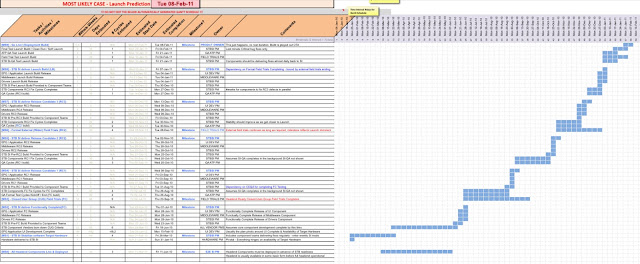Today, after 19 months of joining the company & about 18 months from getting involved with ongoing projects, we finally decided to have a discussion around the topic of "Sanity testing" since I had a tendency to always comment on why we continued with downstream testing even though "sanity" had failed, but I was always overridden that it was deemed acceptable for the current stage of the project, and since I wasn't directly involved in managing that project, so I let it be - the timing wasn't right yet...
But even today, on a project that I do have direct involvement in as the overall programme manager, having influenced & steered much of the development / integration / test process improvements to bring the project back on track again, there is still some confusion around what "sanity testing" really means. The technical director managing the launch, who's position in the corporate hierarchy is one level above myself (and the QA manager), has maintained a different view of Sanity Testing than I. But it seems I'm not alone in my view, having recently gained the support of the QA Manager as well as the Product Owner - so we decided it was time to meet and discuss this topic in an open forum, to try and reach an understanding, to avoid confusing the downward teams, and establish a strategy for possible improvements going forward...easier said than done!
One of the challenges I face almost daily is that of enabling change across the project team, sticking my nose into Development / Integration / Test departments with the aim of steering them in the right direction, to help increase the chances of the project delivery. I do this, even though I myself, strictly speaking am positioned within the organisation as a "Programme Manager or Strategic Planner", wearing the hat of Project Management, as if applying PM pressure across the team isn't enough of a thorny subject already, I still go and push for process changes in Dev / Int / QA - am I a sucker for punishment or what?? But I can't help myself really, because my technical background, I've been through all the stages of software engineering as both engineer and manager, and have worked for the best companies in the industry, who, through the years evolved to using best practises -- so when I see things being done that deviates from what I consider the norm in the industry, I just can't help myself, but to intervene and provide recommendations because I can help short-circuit the learning curve and help the team avoid repeating expensive mistakes!
And so with the topic of QA Sanity, we've never respected the term, and continue, despite failing sanity, to proceed with testing an unstable product, in the hope of weeding out more failures:
But even today, on a project that I do have direct involvement in as the overall programme manager, having influenced & steered much of the development / integration / test process improvements to bring the project back on track again, there is still some confusion around what "sanity testing" really means. The technical director managing the launch, who's position in the corporate hierarchy is one level above myself (and the QA manager), has maintained a different view of Sanity Testing than I. But it seems I'm not alone in my view, having recently gained the support of the QA Manager as well as the Product Owner - so we decided it was time to meet and discuss this topic in an open forum, to try and reach an understanding, to avoid confusing the downward teams, and establish a strategy for possible improvements going forward...easier said than done!
One of the challenges I face almost daily is that of enabling change across the project team, sticking my nose into Development / Integration / Test departments with the aim of steering them in the right direction, to help increase the chances of the project delivery. I do this, even though I myself, strictly speaking am positioned within the organisation as a "Programme Manager or Strategic Planner", wearing the hat of Project Management, as if applying PM pressure across the team isn't enough of a thorny subject already, I still go and push for process changes in Dev / Int / QA - am I a sucker for punishment or what?? But I can't help myself really, because my technical background, I've been through all the stages of software engineering as both engineer and manager, and have worked for the best companies in the industry, who, through the years evolved to using best practises -- so when I see things being done that deviates from what I consider the norm in the industry, I just can't help myself, but to intervene and provide recommendations because I can help short-circuit the learning curve and help the team avoid repeating expensive mistakes!
And so with the topic of QA Sanity, we've never respected the term, and continue, despite failing sanity, to proceed with testing an unstable product, in the hope of weeding out more failures:
- What does Sanity mean?
- What do we do when Sanity fails?
- Do we forsake quality until later in the project?




